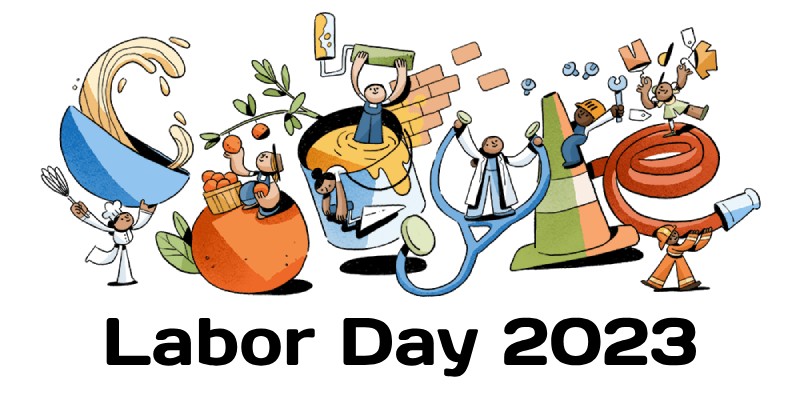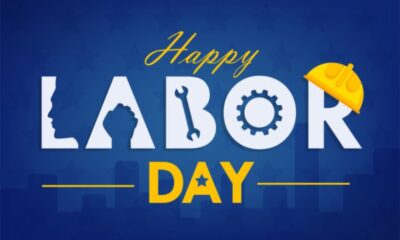Festivals & Events
Interesting Facts about Labor Day 2023 You Should Need to Know Everything

The majority of Americans support Labor Day as a holiday! Yes, it signals the sad end of summer, but it also signifies a day with a lot of significance. One benefit is that it gives us yet another reason to celebrate Labor Day activities like grilling out, hosting pool parties, and using our creative summer Instagram posts. Include us! While all of those reasons alone make Labor Day a day to be enjoyed, there is also some more background to the holiday’s significance. Here is all the information you require for the summer holiday, including the date of Labor Day 2023.
Labor Day honors the men and women who fought tenaciously for workers’ rights during the late 19th-century labor movement. Many of the rights we enjoy and take for granted today, such as a 40-hour work week, safe working conditions, paid time off, and sick leave, are the result of their tenacious victories. These people understood that without economic freedom for the working class, there could be no freedom and liberty in this nation.
The festival celebrates American workers, unions, and labor leaders, who are the backbone of this country. Whatever you choose to mark Labor Day in 2023, make sure to take some time to remember and honor all the workers—past and present—who made America what it is today.
You might be wondering at this point when Labor Day is in 2023. What is the background of Labor Day? Below you’ll find answers to these and other questions, along with the exact date of this year’s celebration.
What Day Is Labor Day?
Every year, the first Monday in September is designated as Labor Day in the US and is a national holiday in the US. It is a day to honor American workers and has its roots in the labor movement.
Labor Day is observed with barbecues, sporting events, and street parades. Around Labor Day, the American football season starts.
So, when is Labor Day in 2023?
Labor Day in 2023 will fall on Monday, September 4! Even though the holiday falls particularly on a Monday, everyone is aware that you usually celebrate it over the entire weekend beginning the Saturday before! Therefore, from Saturday, September 2 through Monday, September 4, be ready to unwind.
The first Monday in September is usually observed as Labor Day
That is correct! One of those holidays occurs on a particular day of the week rather than a set date in the calendar. So you may always think about it that way if you could always think about it that way!
What is the history of Labor Day?
Labor Day was already a recognized holiday in 30 states when it was made a federal holiday in the United States in 1894. According to the History Channel, labor movement activists who staged strikes and protests to demand improved working conditions during the Industrial Revolution were responsible for the creation of Labor Day.
According to National Geographic, on September 5, 1882, New York City union leaders organized what is now regarded as the country’s first Labor Day parade. 10,000 employees took unpaid leave on this day to participate in a march through New York City, which culminated in a picnic, fireworks, and dancing. The day was proclaimed “a general holiday for the workingmen of this city” by the organizers. Their concept caught wildfire across the nation, and numerous states established laws establishing the workers’ holiday.
However, Congress didn’t officially recognize the holiday until 1894 as a result of the Pullman strike, a nationwide railroad boycott that proved catastrophic and brought attention to workers’ rights. Amid this severe unrest, Congress made Labor Day a legal holiday to mend relations with American workers.
On June 28, 1894, President Grover Cleveland formally signed it into law. Strangely enough, the Department of Labor was the first department to be directed by a woman, Francis Perkins, yet it was established after Labor Day was declared a holiday.
Although many give labor union leader Peter J. McGuire credit for the idea, the actual creator of Labor Day has remained a mystery for more than a century. Even though the world might never learn about this fact, you now have enough knowledge about Labor Day to fully appreciate everything it stands for.
Labor Day History
The origins of Labor Day go back 130 years to the labor movement’s efforts to better-working conditions in America. It is observed worldwide on May 1 and is often referred to as International Workers’ Day or May Day.
The demand for labor and trade unions increased along with the Industrial Revolution. Eight-hour movements spread around the world in the 1850s to reduce the working day from ten to eight hours. The American Federation of Labor demanded an eight-hour day at its first convention in 1886, which resulted in what is now known as the Haymarket affair. The walkout was to take place on May 1 in Chicago.
When Was the First Labor Day?
The first Labor Day parade took place on September 5, 1882, in New York City. It was started because the Central Labor Union and other labor unions wanted to make a day off for workers. In 1887, Oregon became the first state to officially recognize it as a holiday. By the year’s end, Labor Day holidays had been established in Colorado, Massachusetts, New Jersey, and New York. It became a federal holiday under President Grover Cleveland in 1894.
Who Founded Labor Day?
The originator of the Labor Day holiday is unclear, according to the US Department of Labor. According to some historians, Matthew Maguire came up with the idea for the holiday in 1882 while working as the Central Labor Union’s secretary in New York. Others contend that the American Federation of Labor’s co-founder Peter J. Mcguire proposed a vacation for the “laboring classes” in 1882.
The first Monday in September was chosen as the holiday’s date because it was seen to be more politically neutral than May 1. The extended period between Thanksgiving in November and Independence Day in July was another justification for adding a holiday.
Why can’t you wear white after Labor Day?
The statement that white clothing cannot be worn after Labor Day is just untrue. The final weekend to wear your whites is the federal holiday, even though you may have heard of (or perhaps adhered to) this archaic rule. However, this fashion faux pas is now a thing of the past.
Now that you’re thinking about it, you’re probably wondering how this notion even came to be. The higher class used the prohibition of wearing white after Labor Day in the 19th century to set itself apart from the working class. This is because the elite could wear lighter colors without worrying about stains, whilst laborers frequently wore darker clothing to cover the signs of a hard day at work.
Additionally, those who could afford to travel to coastal trips in the fall to escape the cold would continue to dress in white throughout the winter, in contrast to laborers who were required to transition from white to darker and warmer clothing after the final summer holiday.
That way of thinking eventually persisted. However, you can now wear white after Labor Day without a doubt. We wholeheartedly support doing away with seasonal dress codes and wearing whatever makes you happiest. So, for your Labor Day ensembles, grab your white button-down shirts and linen slacks, and keep them in your closet all year long.
Google Doodle for Celebrating Labor Day 2023
Today’s Google Doodle pays tribute to workers in the US and Canada, as well as those who have worked for and are still fighting for better working conditions on Labor Day 2023. The inaugural Labor Day celebration was a large parade that took place in New York City at the beginning of September 1882.
Trade and labor unions joined forces and staged strikes in the 19th century to demand employment standards like 40-hour work weeks, paid time off, safety precautions, and sick leave that are now frequently disregarded. Union officials started pushing for a day of recognition for the contributions that workers provide to society. The Central Labor Union approved a proposal for the event and got to work planning the first parade in New York City.
It was initially made a legal holiday in 1887 in Oregon. By the end of the year, many had done the same, but it wasn’t until 1894 that it was declared a federal holiday in the United States and Canada.
-

 Tech3 weeks ago
Tech3 weeks ago12 Essential Marketing Tools Every Small Business Owner Should Try
-

 Business4 weeks ago
Business4 weeks agoSmart Strategies to Stay One Step Ahead in a Competitive Market
-

 Business4 weeks ago
Business4 weeks ago9 Low-cost Marketing Strategies and Ideas That Offer a Good Return on Investment for Small Businesses
-

 Startup2 weeks ago
Startup2 weeks agoEssential Tips for New Retail Business Owners to Succeed in a Competitive Market
-

 Tech4 weeks ago
Tech4 weeks agoHow Small Business Can Start with Marketing Automation Software
-

 Tech6 days ago
Tech6 days agoAdobe Partner with Benny Blanco to Help Small Business Branding in ‘Create Anything’ Campaign
-

 Business3 weeks ago
Business3 weeks ago7 Essential Investment Success Tips Every Investor Should Know: How to Beat the Market
-

 Tech3 weeks ago
Tech3 weeks agoGoogle’s Change to Google Local Services Ads Could Have an Impact on Millions of Small Businesses






















